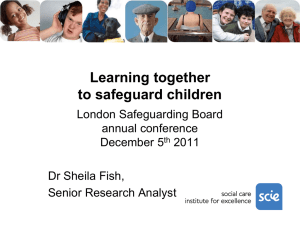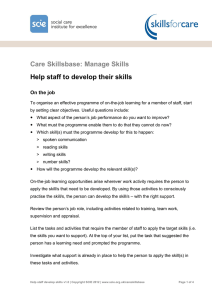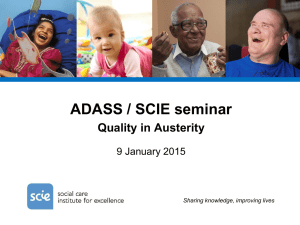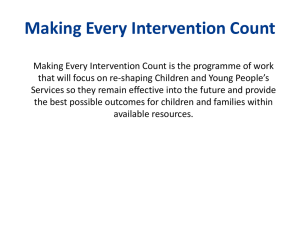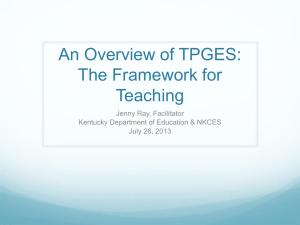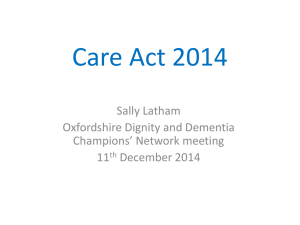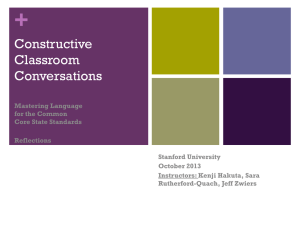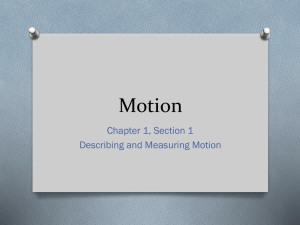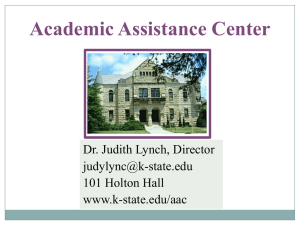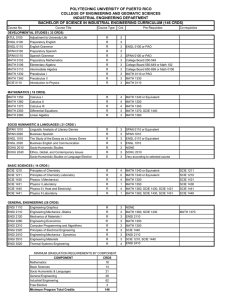Dr Sheila Fish - The SCIE - London Safeguarding Children Board
advertisement
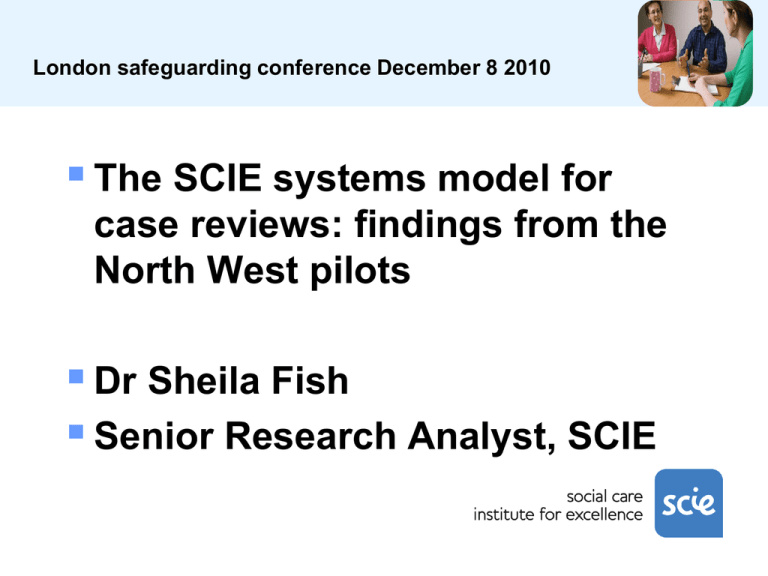
London safeguarding conference December 8 2010 The SCIE systems model for case reviews: findings from the North West pilots Dr Sheila Fish Senior Research Analyst, SCIE The “systems approach” Is a way of thinking or ‘conceptual framework’ for understanding practice How do we understand what causes good or poor practice? and a structured process for learning from practice through analysing a particular case What is the systems approach in essence? Trying to answer the ‘why’ questions, and tackle the ‘latent conditions’ of error “Active failures are like mosquitoes. They can be swatted one by one, but they still keep coming. The best remedies are to create more effective defences and to drain the swamps in which they breed. The swamps, in this case, are the ever present latent conditions.” James Reason Key parties involved Process structured around key meetings The review team meet with the case group for an introductory meeting, individual conversations and two group ‘follow on’ meetings The review team meet alone for an initial planning meeting to review relevant documentation and for ‘analysis meetings’. Tools provided include: Structure/schedule for individual conversations with key staff Framework of contributory factors Table layout for organising analysis of practice in ‘key practice episodes’ Typology of underlying patterns of systems influence to organise the findings North West Pilots Funded by RIEP Supported by (then) Government Office NW Undertaken by Wirral, Salford and Lancashire Safeguarding Children Boards SCIE team led the process, working collaboratively with SCR Panel members to form the ‘review teams’ Findings appear positive 3 case reviews were carried out: identified issues critical to how the case had developed and aspects that explained how professionals had handled it, and presented these in a comprehensible format identified underlying patterns that were not conducive to, or supported, good safeguarding practice and, as far as possible, translated these in to recommendations produced learning that is already, and will continue to be, acted upon. What were the findings like? A. Learning encapsulated in the findings & recommendations B. Learning accomplished through the process Learning encapsulated in the findings & recommendations Aim is to make the case act as ‘a window on the system’ (Charles Vincent 2004) Good or problematic practice may look the different in different cases but the sets of underlying influences may be the same Involves moving from the case specific details to identify generic, underlying patterns Patterns that support good practice or create conditions in which poor practice is more likely A six part typology supports this analysis Starts to shape thinking about recommendations Typology of underlying patterns of ... 1. 2. 3. 4. 5. 6. human-tool operation family-professional interactions human judgement/reasoning human-management system operation communication and collaboration in multiagency working in response to incidents/crises communication and collaboration in multiagency working in assessment and longerterm work Examples from the pilots 1. patterns of human reasoning The garden path error 2. patterns of human-management system operation Lack of financial oversight of total care package 3. patterns of multi-agency work Lack of availability of schools to give timely information 1. Patterns of human reasoning Much psychological research on cognitive strengths and weaknessess Building safe systems needs to be premised on realistic ideas of cognitive abilities Biased basis for judgement in this case typified a classic error of human reasoning The garden path syndrome Part of broader error whereby once we have formed a view we fail to notice or dismiss evidence that challenges it Garden path especially difficult as earlier clues suggest plausible but false answers; later cues weaker Linked to C4EO safeguarding briefing – overview of cases in light of changing circumstances and new information Link to critical review aspect of supervision Recommendation not admonishing Drawing out logical consequences if this aspect missing Fudging accountability not acceptable Assess cost-effectiveness 2. Human – management system Resourcing Controls on some forms of expenditure and not on others Front line worker CAN allocate more time or refer to family support without requiring consent, CAN NOT do same for specialist assessment – though could make a valuable contribution to understanding family’s problems and peparing appropriate plan This contributes to shaping the care plan by making certain options easier than others Compounded by lack of financial oversight of overall cost of care package 3. multi-agency working Case specific issue: S47 during school holidays Input from staff highlighted how they would never wait, overrun timescale, if case going to be closed NB. Not beating up on social worker but thinking how do we make this easier? Generic issue: lack of availability of schools to provide timely info Challenge to the Board: how to achieve above Reflections from the pilots Found this step provided clarity about ‘findings’ Some substantiated with reference to relevant research Felt it encouraged them to grapple with quite fundamental issues ‘The learning points are also much more fundamental – the next question is what does an action plan look like that reflects that ‘The learning has already been richer, deeper and it’s been better as a process.’ Could see how it would make collating findings across multiple reviews easy ….and views from LSCBs “we can’t unlearn what we’ve learnt today – we will be more critical of recommendations that suggest tinkering with policies and procedures. You can see how these will change practice; others just turn into churn” Learning accomplished through the process SCIE Guide states that staff directly involved in the case play an active role when using this model Quality of their engagement is linked to quality of understanding of practice and of learning gained But what of the impact of the process itself on learning outcomes and impact? A key learning point from the pilots is how the process itself becomes a powerful learning exercise for those involved The extent to which surprised us Secured effective learning and change Participants were not waiting on a final report; learning was happening from the word go By the end some had reviewed their own practice, & revised their own knowledge Changes both for individual workers but also examples of ‘ripple’ effect as they talk with their colleagues about the process and learning Often learning gained was about each other’s agencies & roles about understandings e.g. misconceptions about other agencies, or clarity about what effective multi-agency working actually means in practice Nb. in pilots we didn’t adequately capture this learning in the final reports I’ve learnt ..in terms of the outcomes of the case review – now I always have in mind the “garden path” thing. I’ve gone back to other cases and thought; actually, why am I working with this family? (social care) Comments from practitioners What supported the attainment of those learning outcomes? 1. Data collection methods – individual conversations Distinguishing features of the individual conversations: Start by letting the staff member tell their story in their way Probe further to understand how they were seeing the world Identify any key episodes Explore what was influencing them as workers, using list of ‘contributory factors’ Contrast with usual process How the conversations helped Staff more open Gained much richer data e.g. Whether a course of action was considered and then rejected or just considered at all Insight into what actually goes on on the ground‘usual’ ‘regular’ practice How are competing priorities being managed A view on how strategies actually impact on direct work with families An indication of how organisational priorities are perceived at the front line 2. How you treat the data in the SCIE model Not prioritising material from files over input from staff – whichever you do first is arbitrary Collating information as you go along Being led by the material, not by pres-set notions of what is significant Selecting ‘episodes’ that need detailed analysis Judging practice not against an ideal or against procedures but in context of actual practice realities Explicitly trying to identify generalizable learning through ‘underlying patterns’ concept Having discussions about which findings are should be prioritized 3. Doing the analysis work together A collaborative learning process ‘review team’ of senior managers from across agencies working together from the beginning Contrast usual IMR process Do conversations together Numerous ‘analysis’ meetings to pull the story together, identify key episodes, underlying issues etc ‘review team’ working with the ‘case group’ of staff directly involved through two ‘follow-on’ meetings How did review team set up help in getting to the learning outcomes? created a common purpose less defensive than the IMR process; access to all data, and ‘un-digested’ contrast to IMR process developed joint ownership of the problems of how staff work together and joint effort to find solutions 4. Staff having chance to be part of analysis – “follow-on” meetings Changed name from ‘feedback’ meetings to stress that these are key part of the process of analysis 1st follow-on share ‘emerging’ analysis Chance for staff to correct, challenge, amplify 2nd follow-on focus more on the underlying issues; want input about practice realities around these issues more generally Staff get chance to help think about potential solutions How did ‘follow-ons’ help? Reinforces the focus on learning Allows staff to see the whole picture, not just the slice they were involved in and longer term outcomes keeps analysis and recommendations grounded in realities of practice Allows professionals to reflect and discuss together -forges links across agencies/professions and hierarchical positions through review team & case group working together Not all plain sailing! Administration and Co-ordination ‘Fear of the unknown’ “Getting your head around it is a really big deal and that shouldn’t be underestimated” Because it is more open in lines of enquiry, it is a messier process which can provoke anxiety Involving the right practitioners at the right time to militate against potential reluctance Who would be leading the analysis if not SCIE? Importance of social science research methods knowledge & group facilitation skills Summary. Learning outcomes were supported by: 1. 2. 3. 4. 5. 6. 7. Not having a detailed terms of reference but going in ‘with an open mind’ Gaining richer data through staff involvement Multi-agency ‘review team’ working/learning together from the beginning – no IMRs Analysis focuses on ‘why’ – ‘key practice episodes’ & ‘contributory factors’ framework Use of social science research methods – rigour and reliability Staff having chance to be part of developing analysis Use of typology of underlying patterns to guide deeper level of analysis nb. Would require change to statutory guidance to be usable in SCRs Terms of Reference IMRs Comprehensive chronology How to be ‘child centred’ Reference to procedures ADCS recommendation: There should be a clear focus on removing the bureaucracy and levels of prescriptive processes, including those surrounding the current Serious Case Reviews (SCR) process, in order to free front line practitioners to adopt a ‘learning from practice’ approach to their work. This must include a radical overhaul of the current statutory guidance Working Together to Safeguard Children and Young People For further info Evaluation report & example final report on http://www.scie.org.uk/publications/learningto gether/pilots.asp SCTV film forthcoming Contact: sheila.fish@scie.org.uk Subsequent pilots: West Midlands; London; South West
